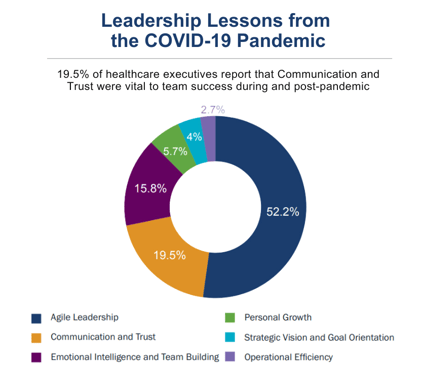In Part 2 of the leadership survey series, 19.5% of healthcare executives say communication and trust were key to success during and post-pandemic.
Our chairman, Bob Clarke, and principal, Tim Frischmon surveyed thousands of healthcare executives to uncover their leadership lessons from the COVID-19 pandemic. 19.5% of healthcare leaders say communication and trust were vital to navigating the pandemic. In part two of this three-part series, we share those meaningful insights gathered around the importance of communication and trust in healthcare leadership during times of crisis.

In part one of this series, we learned that the challenges of the COVID-19 pandemic tested traditional leadership models, igniting teams to carve out new paths for engagement. This transformation in healthcare resulted in the rise of Agile Leadership. With the world undergoing rapid changes, healthcare leaders have played a crucial role in guiding their organizations through uncertainty and enabling them to thrive by fostering teamwork, a sense of community, and loyalty.
As we examine flourishing organizations, we need to understand how such teams navigated these challenges so we can implement their valuable insights and strategies for future success across the industry.

How COVID-19 Affected Communication and Trust
We asked thousands of healthcare executives to share their leadership lessons from the COVID-19 pandemic and explore how their leadership style has changed since 2020. The answers were inspiring, with many executives highlighting the importance of effective communication and trust in times of crisis. 19.5% of respondents revealed that communication and trust were competencies they honed during the pandemic that have helped them succeed no matter the challenges they have faced in the years since.
The following explores the importance of communication and trust in this new era of healthcare and provides you with tools to cultivate psychological safety and innovation within your organization.
Effective Communication Builds Trust
In healthcare, effective leadership communication is the foundation of building trust within a team. However, healthy, effective communication goes beyond the flow of information; it's about fostering a two-way dialogue that values and encourages understanding, teamwork, and mutual respect. Authentic leaders who consistently communicate with transparency and clarity are regarded as dependable—an essential component for building trust.
Building Organizational Trust During a Pandemic
Imagine a workplace where your team is hitting peak performance, experiencing well-being, and contributing to better outcomes. That is the power of a psychologically safe workplace environment. While safety is paramount, building trust goes beyond just safety; it's also about honest, consistent communication that bridges the gap between diverse stakeholders—the clinicians, patients or clients, administrators, employees, members, external partners, and the communities you serve. Building trust is vital during a crisis, as leaders must help teams navigate rapidly changing business needs, procedures, and protocols. Respondents revealed that developing these skills made them and their teams more resilient and prepared to undertake the unforeseen challenges ahead.
Why is Communication Important in Healthcare Leadership?
Our survey reinforced that trust, effective use of remote communication tools, and clarity of expectations are keys to a successful healthcare organization, regardless of sector, particularly amid a crisis. This involves more than simply passing along information to others. It is about building strong connections that allow for the free flow of ideas and innovation. Additionally, effective communication is foundational to cultivating a psychologically safe team culture where all team members can succeed.
When leaders are attentive listeners, encourage feedback, and validate their team members' experiences, they create an environment where everyone feels comfortable sharing their thoughts and ideas without fear of backlash. This openness empowers individuals and increases trust and respect for leaders.
Effective leadership communication is a catalyst that strengthens the bond between team members and leaders, fortifies trust, and sets the stage for accelerated team performance.
How do you build Psychological Safety in Teams?
Here are the five principles of psychological safety in teams:
- Celebrate Open Communication: In an environment where opinions are respected, team members are more likely to voice their thoughts, ideas, and concerns. This openness sparks rich discussion, diversity of thought, and innovative solutions.
- Nurture Trust: Trust blossoms when people know their input will be met without ridicule or punishment. As a leader, you can cultivate this trust, which is the bedrock of strong working relationships.
- Champion Learning & Growth: A psychologically safe space is one where mistakes are stepping stones to learning, and opinions are valued. Here, team members are more willing to take risks, collaborate, and experiment, fostering a culture of continuous improvement and growth.
- Boost Team Collaboration: A team that feels safe collaborates, shares, and works effectively toward common goals.
- Elevate Performance: Research shows that teams with high psychological safety outshine others. Cultivating such teams is the most sustainable competitive advantage any organization can have because it accelerates team performance.
Survey Responses: Psychological Safety Examples
Throughout our survey, executives shared that communication and trust have emerged as crucial elements since the pandemic.
Flexibility is the new name of the game. Trust is paramount. Extend it as liberally as possible. If you find yourself being skeptical, discover why and address it versus withholding trust as a general mindset. The need for authentic community in creating a sense of belonging—to know and be known—within the context of work, despite all of our technological advances, has never been greater. As the war for scarce talent resources wages on, experience and environment will emerge as differentiators. ~ Janet Smith-Hill, CHRO – SSM Health
I draw my energy and passion from personally interacting with colleagues and team members. The pandemic significantly impacted the way we interact with each other. It takes greater effort and creativity to make virtual interactions meaningful and have a purpose. Just when you think you are doing enough - do more! I learned that planning and more deliberate actions are needed to deeply impact colleague engagement. ~ Christopher Ciano, former President – Aetna Medicare, Aetna/CVS
I have found it absolutely necessary to hold more 1:1s with our frontline workers, not just my directs, so people feel individually seen and listened to and that their individual issue(s) will be addressed. I have also learned the importance of acknowledging the challenges of leading during difficult times openly and having people see that I rely on the team's support to succeed at work. ~ Cheryl Pegus, Managing Director – Morgan Health
Logic, reason, and research are not sufficient to motivate behavior, even with a scientifically trained workforce. Instead, leaders must instill trust throughout the organization, leader-to-leader, leader-to-employee, and employee-to-employee. And this culture of trust should (ideally) be solidified long before a leader needs to rely upon it. ~ Corbette Doyle, Board Advisor - Bridge My Return & Havarti Risk Services; Former Senior Lecturer - Vanderbilt University
1 - The value & importance of ongoing (almost constant) communication. This helped generate trust that we/leadership were being strategic & thoughtful; it also helped prevent employees from ‘filling in the blanks’ with their own assumptions.
2 - My credibility as a leader was enhanced when I clearly differentiated between science/facts vs my interpretation/opinion about the facts. This was especially important when I discussed COVID vaccination. ~ Dr. Archelle Georgiou, Chair - Children's Minnesota & KSTP Health Expert – KSTP-TV
The last 4 years have taught me how critical relationships are to building a company, both among our colleagues and with customers. As we navigated Zoom and remote communications, I learned to be more deliberate about creating interpersonal connections. Connections I took for granted when we were in person. ~ Carolyn Magill, CEO – Aetion
Psychological Safety Team Exercises – NuBrick Partners
Take a moment to ponder the ripple effect of psychological safety. Productivity, collaboration, innovation, and problem-solving thrive under its influence. As a leader, understanding this impact can accelerate your team's performance.
To help you get started, our leadership experts at NuBrick Partners put together a list of practical tools executives can use to build healthy communication and trust more effectively by cultivating a psychologically safe environment that values individual contribution. Access our Conscious Inclusion Webinar on-demand and unlock optimized team performance with our holistic, integrated approach to leadership development.
Going Beyond Communication and Trust
Effective communication and trust-building are pivotal and have become the new normal in healthcare leadership. Each contributes to a healthy work environment that fosters engagement and collaboration, improving patient outcomes, employee retention, and client satisfaction.
Stay tuned for the finale of our three-part series of leadership lessons from the COVID-19 pandemic. In it, we will discuss how emotional intelligence and team dynamics helped healthcare organizations thrive during challenging times and how your team can use those lessons to improve organizational performance. Catch up on part one of the series here.
* Disclaimer: The opinions expressed in direct quotes are solely those of the respondents and not necessarily those of their respective organizations, Furst Group, or NuBrick Partners.


